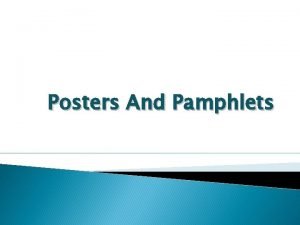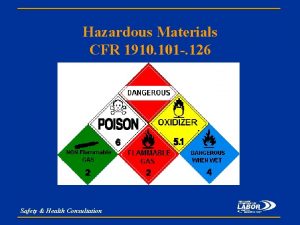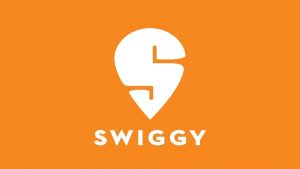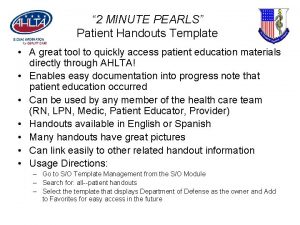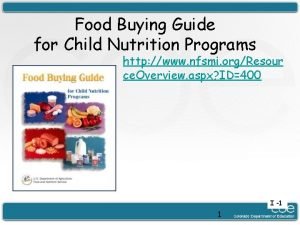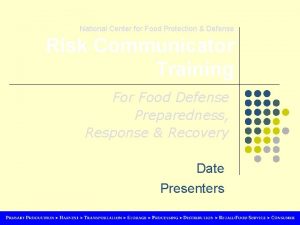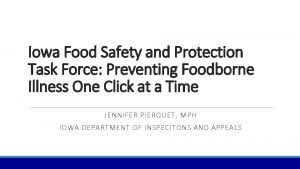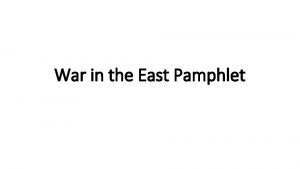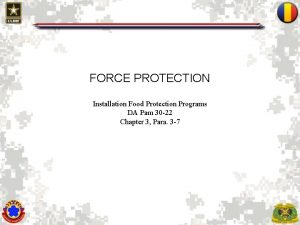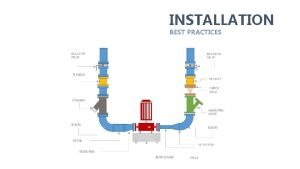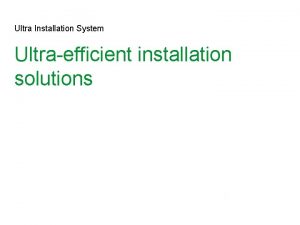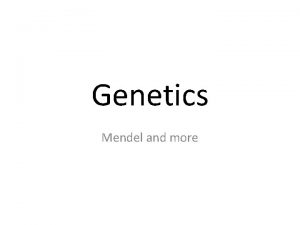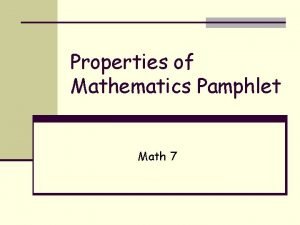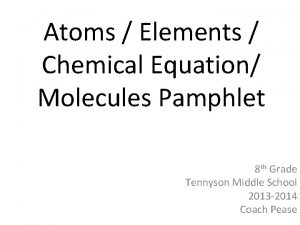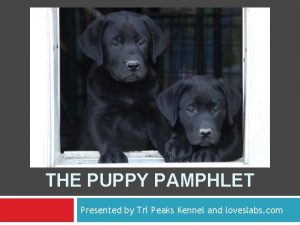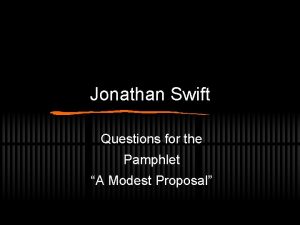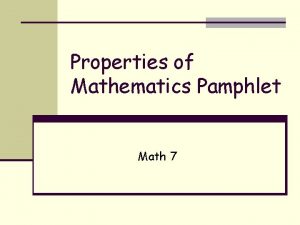Food Protection Installation Food Protection Programs DA Pamphlet








![Food Risk Management Temperature Standards [O F] CAT FOOD 1 Whole muscle beef, Lamb, Food Risk Management Temperature Standards [O F] CAT FOOD 1 Whole muscle beef, Lamb,](https://slidetodoc.com/presentation_image_h2/8c0f1c80ecf4877056081767c9f95088/image-9.jpg)







- Slides: 16

Food Protection • Installation Food Protection Programs DA Pamphlet 30 -22, Operation Procedures for the Army Food Program, Chapter 3, paragraph 3 -7. • Purpose is to Reiterate food protection requirements as prescribed by regulation. (DA PAM 30 -22/TB MED 530). • Provide reinforcement of: – Food Risk Management procedures. – Risk management responsibilities of the Dining Facility Manager and Food Program Manager. – DA Forms 7458 & 7459. • Provide guidance for food risk management implementation and follow-up. Warrior Logisticians 1

Introduction • Proactive development & execution of food safety & sanitation procedures. • Coordination with supporting Prev. Med activity. • Installation food safety & sanitation program requirements: – Army Food risk management/Composite Risk Mgmt. – Food safety & sanitation training. – Integrated pest management/TB MED 530/Section VIII. …promotes the efficient allocation of resources by identifying systemic problems associated with facilities, equipment, or personnel training. Warrior Logisticians 2

Training & Integrated Pest Management • Food Sanitation Training: – Supervisor Certification required every 4 years. – 4 hours annual refresher for all workers. – 8 hours initial training of all food service personnel prior to beginning work. • Integrated Pest Management (IPM) Plan: – Food Program Manager develops. – Coordination with Dining Facility Manager, PM, & DPW. – Track structural deficiencies & corrective actions. – Prescribes non-chemical controls & guidance for initiating pest control contracts. Warrior Logisticians 3

The Army Composite Risk Management Process 2 Assess Hazards “Assessment” 3 1 Identify Hazards Develop Controls & Make Risk Decision “Management” 5 4 Supervise & Evaluate Implement Controls Warrior Logisticians 4

Food Risk Management Food RM = Applying HACCP Principles Conduct a Hazard Analysis (ID PHFs & hazards) Identify Hazards 7 Establish a Record. Keeping System Assess Hazards SEVERITY 1 PROBABILITY A B C D I 2 Determine Critical Control Points II IV The Risk Management Supervise & Process Evaluate Verify Program: 6 E (Review, Revise, Evaluate) Develop Controls 3 Establish Implement Controls Develop Corrective 5 Actions Critical Limits for each CCP 4 Monitor CCPs 5 Warrior Logisticians

Food Risk Management Warrior Logisticians 6

Food Risk Management …enhances the prevention of food-borne illnesses by systematically applying prescribed food protection & sanitation standards. • Monitor time & temperature controls for PHFs. • Incorporation of HACCP principles: – Monitoring Procedures. – Critical Control Limits (identified by hazard symbols on the production schedule with in SCP-14). – Record Keeping. • Defined Processes for Monitoring: – Cold holding & storage. – Hot holding. – Cooking. Warrior Logisticians 7

Food Risk Management TABLE 3 -1 (Minimum Monitoring Requirements) Warrior Logisticians 8
![Food Risk Management Temperature Standards O F CAT FOOD 1 Whole muscle beef Lamb Food Risk Management Temperature Standards [O F] CAT FOOD 1 Whole muscle beef, Lamb,](https://slidetodoc.com/presentation_image_h2/8c0f1c80ecf4877056081767c9f95088/image-9.jpg)
Food Risk Management Temperature Standards [O F] CAT FOOD 1 Whole muscle beef, Lamb, & Veal; Made-to-order eggs; Fish; Canned Hams; Cooked Vegetables; All other pre-cooked foods packaged by industry. 145 (Internal product for 2 Ground beef products (hamburgers, cubed steak); Pork products; Bulk-prepared scrambled eggs; 155 (Internal product for 3 Poultry products; Stuffed products (meats, pastas, peppers, etc…); Re-heated leftovers; Microwaved foods; 165 (Internal product for All cooked foods held hot on the serving line and in warmers. 140 (Internal product) 1 15 sec) 2 All chilled PHFs in refrigerated storage, cold sandwich bars, & salad bars: cut fruits & vegetables; mixed salads (potato, tuna, chicken, egg, etc…); custards & puddings. 40 (Internal product) U=you All refrigeration units (reach-in & walk-in); salad bars; sandwich bars; dessert bars (containing custards & puddings). Must maintain an ambient temperature of 38 degrees 38 (Ambient) Warrior Logisticians 9

Food Risk Management DA Form 7458 - Cooking Warrior Logisticians 10

Food Risk Management DA Form 7459 – Hot/Cold Holding Warrior Logisticians 11

Food Risk Management Two-Step Cooling Method • The two step cooling method is a requirement (TB MED 530). • 1 st step – 140 to 70 within the first two hours after being removed from the line. • 2 nd step - 70 to 40 within four hours after being placed under refrigeration. • Ice bath after changing to shallow pans and making batches smaller, blast chill if you have the capability. Warrior Logisticians 12

Food Risk Management How to implement • Have blank copies of DA Forms 7458 & 7459 on hand. – Simply attach to production schedules. – ensure forms are available to all shift leaders/supervisors (ask yourself ! Is this a paperwork drill or are we actually doing this? ). • Dining Facility Manager reviews programmed menu for the week (SCP 14 will identify all PHF’s). – Pre-select menu items to be monitored for each meal period each day. – Enter item description & category on appropriate forms (cooking, cold holding, hot holding). – Identify individuals responsible for monitoring (by meal period and day). – Get the cooks who are cooking involved. Warrior Logisticians 13

Food Risk Management How to… • Dining Facility Manager spot checks monitoring logs at end of each meal period. – Ensure monitoring was performed. – Ensure forms completed properly. – Ensure forms are legible. – Note any food safety violations. • Dining Facility Manager collects & files monitoring logs. – At end of each day. – Note recurring discrepancies. – File with Production Schedules. Warrior Logisticians 14

Food Risk Management How to… Follow-up Actions • Program training to address recurring deficiencies and who is responsible for what. – Cooking temperatures. – Hot/cold holding temperatures (mark gauges on steam tables and cold bars). – Cooling methods. – Thermometer calibration. • Initiate & track work orders to correct faulty equipment. – Hot water capability of steam table. – Temperature calibration of warming units, griddles, ovens, and refrigerators. Warrior Logisticians 15

Questions? Warrior Logisticians 16
 Cpmcd full form
Cpmcd full form David whitmer grave
David whitmer grave Text types in english
Text types in english Advantages and disadvantages of posters. pdf
Advantages and disadvantages of posters. pdf Illness in recovery na
Illness in recovery na A pamphlet explaining how an unborn child
A pamphlet explaining how an unborn child Osha 1910 psm
Osha 1910 psm Citizenship in the nation
Citizenship in the nation 2062 shortage annex
2062 shortage annex Objective of swiggy
Objective of swiggy Patient education handout template
Patient education handout template Photography merit badge pamphlet
Photography merit badge pamphlet Fbg calculator
Fbg calculator Unit 2 food food food
Unit 2 food food food Sequence of food chain
Sequence of food chain National center for food protection and defense
National center for food protection and defense Www.youtube.com
Www.youtube.com



